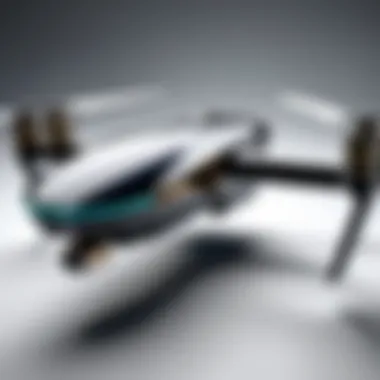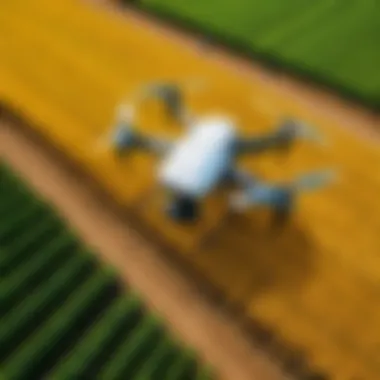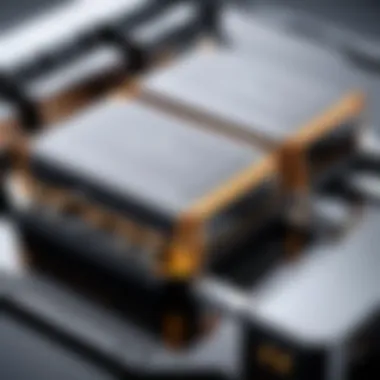The Evolution of Small Drones with Long Battery Life


Intro
The rise of small drones has changed various industries in significant ways. Among the most important factors is battery life. A drone's battery is its lifeblood, determining how long it can operate and what it can accomplish. Advances in battery technology have enabled small drones to carry out intricate tasks for extended periods, impacting their overall functionality, user experience, and application in several sectors such as photography, agriculture, and surveillance.
Improved battery life is pivotal. It allows for longer flight times and increased efficiency, making drones more attractive for both professionals and hobbyists. This article will explore how technology has evolved in this arena, discussing key product features, technical specifications, and performance analyses. In doing so, it aims to shed light on the essential role of battery technology in modern small drones.
Product Overview
The evolution of small drones with long-lasting batteries centers on several key features. Modern drones have embraced various innovations that enhance their performance and utility.
Key Features
- Enhanced Battery Capacity: Recent models utilize lithium-polymer batteries, which provide more power without significantly increasing weight.
- Intelligent Battery Management Systems: These systems optimize battery usage and help extend overall battery lifespan. They also offer users more precise information regarding charge levels and health.
- Lightweight Materials: Incorporating advanced materials like carbon fiber has improved the overall design of drones, contributing to both performance and battery efficiency.
- Modular Design: Many new drones come with easily replaceable batteries, making it convenient for users to swap them out for longer sessions.
Technical Specifications
The technical specifications of small drones often reflect the emphasis on battery technology. Here are some specifications commonly found in leading models:
- Battery Type: Lithium-polymer, with some models featuring the ability to charge quickly.
- Flight Time: On average, high-performing drones can achieve flight times exceeding 30 minutes on a single charge.
- Charging Time: Quick charging capabilities allow batteries to replenish in under an hour.
- Weight: Variations from 250 grams to 2 kilograms, impacting portability and ease of use.
Performance Analysis
To truly understand the advantages offered by improved battery life in small drones, it is essential to conduct a performance analysis based on benchmark tests and real-world scenarios.
Benchmark Test Results
Benchmarks typically evaluate several metrics:
- Average Flight Time: Proven flight durations often exceed ten percent improvements in models with advanced batteries compared to older generations.
- Payload Capacity: Enhanced battery life allows for increased payload capacities, enabling drones to carry heavier cameras and other equipment.
- Stability and Control: Longer battery life contributes to better stability during longer flight times, particularly relevant when capturing images or doing precise tasks.
Real-World Usage Scenarios
Real-world examples highlight how improved battery performance extends the usability of small drones.
- Photography: Drones like the DJI Mavic Air 2 have revolutionized aerial photography by providing longer flight times, which means better framing and capturing of crucial moments.
- Agriculture: In agriculture, drones equipped with long-lasting batteries increase efficiency while monitoring crop health or delivering pesticides.
- Surveillance: Longer battery runtime enhances capabilities in surveillance, allowing for extended monitoring periods during law enforcement or security operations.
"As battery technology improves, small drones become significantly more capable, impacting industries from agriculture to emergency services."
Closure
Preface to Small Drones
Small drones have become a vital instrument across various industries. Their versatility and cost-effectiveness drive a significant interest among IT professionals and tech enthusiasts. This section will shed light on their definitions, unique characteristics, and the remarkable growth these devices have seen in recent years.
Definition and Characteristics
Small drones, also known as unmanned aerial vehicles (UAVs), are typically defined by their compact size and multifunctional capabilities. They can vary in size from that of a small bird to those that can carry heavier loads. A key characteristic is their ability to be controlled remotely or operate autonomously, making them valuable in numerous applications.
Technologically, many small drones are equipped with essential features, such as high-definition cameras, GPS navigation, and obstacle avoidance systems. The flight stabilization technology is crucial as it enhances control, allowing even novice users to operate them effectively. The development of lightweight materials helps improve their maneuverability while extending battery life, a critical aspect to consider in their design.
Market Growth and Adoption Trends
The small drone market has observed substantial growth in recent years. according to various industry analysts, the global small drone market is projected to expand significantly over the next decade. This surge can be attributed to several factors:
- Increased Applications: Drones are now used in fields like logistics, agriculture, and surveillance, contributing to their rising popularity.
- Technological Advancements: Innovations in technology, particularly in battery life, have allowed drones to perform more complex tasks over extended periods.
- Affordability: As production costs lower, more consumers and businesses find these devices accessible.
Furthermore, drone regulations are evolving to support market growth. Governments are more inclined to develop frameworks that enable wider drone usage, enhancing market adoption.


In summary, small drones represent a significant advancement in technology, presenting numerous benefits in various sectors. Their ongoing evolution, anchored on improvements like enhanced battery life, continues to redefine what these aerial systems can achieve.
"The future of small drones is promising, driven by continual advancements in technology and growing applications across all sectors."
Understanding the intricacies of small drones lays the foundation for discussing their operational enhancements, focusing on battery technology in the following sections.
The Importance of Battery Life
Battery life in small drones is a crucial aspect that determines their usability, versatility, and overall performance. As technology advances, the demand for small drones with longer battery life continues to grow. Battery capacity directly influences the drone’s ability to complete tasks efficiently and effectively. Therefore, understanding the importance of battery life is fundamental for manufacturers, users, and stakeholders in the drone industry.
Role in Extended Flight Time
Extended flight time is one of the most significant advantages provided by improved battery technology. For users, longer flight times mean less downtime spent recharging and more time spent completing essential tasks. Relying on a drone that only achieves short flight durations can be frustrating, especially in professional settings where efficiency is vital. An increase in battery life can also allow drones to cover larger areas in a single flight.
- Early drones typically had flight times limited to 10-15 minutes.
- Modern models equipped with advanced Lithium-Polymer batteries can achieve flight times of 30-60 minutes.
The enhancement in flight time stems from ongoing advancements in battery technology. As batteries become more efficient, they store and deliver energy more effectively, allowing drones to remain airborne longer. As the industry continues to innovate, many expect even greater flight times to be possible, reshaping the landscape of drone applications.
Impact on Operational Range
Battery life also has a direct impact on the operational range of drone missions. A drone with longer battery life can travel greater distances without needing to return for a recharge. This feature is particularly important in industries like agriculture, search and rescue, and surveillance.
- In agriculture, drones can survey larger fields and collect more data in a single flight, providing farmers with better insights into crop conditions.
- In search and rescue, drones can cover vast terrains, potentially saving lives by reaching areas that would otherwise be inaccessible.
- In surveillance, extended operational range allows for more comprehensive monitoring of critical locations, enhancing security and safety measures.
An efficient battery system supports greater flexibility in planning missions. Users can design routes with confidence, knowing that their drones can sustain prolonged operations without interruptions.
The evolution of battery technology has not simply enhanced the performance of drones; it has expanded their operational possibilities, paving the way for innovative applications across various sectors.
Current Battery Technologies in Small Drones
The emergence of small drones with longer battery life hinges on the innovations in battery technology. Battery technology not only determines the flight duration but also influences the overall performance and usability of drones. As the market for small drones grows, understanding the current battery technologies becomes essential. These technologies ensure that drones can meet the increasing demands of users engaged in various applications, from aerial photography to surveillance.
Lithium-Polymer Batteries
Lithium-polymer batteries are among the most popular choices for small drones. They offer several advantages. Their lightweight nature contributes to the drone's overall efficiency. This is critical in maximizing flight time. Moreover, they possess a high energy density, which allows for longer operational durations.
Lithium-polymer batteries also come in various shapes and sizes, making them adaptable for different drone models. However, there are downsides. These batteries can be more sensitive to temperature variations and require careful handling to avoid risks such as puffing or swelling. Users must also be mindful of the charge cycles, as excessive cycling can reduce battery lifespan.
Lithium-Ion Batteries
Lithium-ion batteries serve as another prevalent option. They are known for their longevity and stability in performance. Unlike lithium-polymer variants, lithium-ion batteries generally offer a more robust structure. This can lead to greater durability under various environmental conditions.
The energy density of lithium-ion batteries is also commendable, enabling significant flight times without making the drone excessively heavy. However, they do come with some limitations. Charging times can be longer compared to lithium-polymer batteries. Moreover, lithium-ion batteries have a restricted number of charge cycles, which means they might need replacement sooner for heavy users. Their price point can also vary significantly depending on the quality and manufacturer.
Emerging Alternative Battery Technologies
In addition to widespread options like lithium-polymer and lithium-ion batteries, new technologies are emerging. Some companies are experimenting with solid-state batteries. These provide potential improvements in energy density and safety, reducing risks of fires associated with traditional lithium-based batteries.
Another area of exploration includes hydrogen fuel cells. Hydrogen fuel cells can theoretically offer much longer flight times by converting hydrogen into electricity. However, the technology is still in early stages and faces challenges in terms of efficiency and implementation complexity.
In the field of energy harvesting, researchers are looking at integrating solar technology into drone designs. This could create drones that charge themselves during flight, vastly boosting operational range and flexibility.
Overall, the evolution of battery technology will be pivotal for the advancement of small drones. With improvements in performance and increasing user demands, the landscape for drone batteries will likely continue to change.
Performance Benchmarks of Leading Models
Understanding performance benchmarks is critical when evaluating small drones with long battery life. Performance benchmarks provide a systematic way to compare drones based on key specifications like flight time, operational range, and payload capacity. They play a vital role in informing potential buyers about which model may best meet their needs. By analyzing performance metrics, users can make informed decisions tailored to their specific applications. This section will cover important aspects of these benchmarks, focusing on notable models in the current market landscape.


Comparison of Battery Life Across Popular Brands
The comparison of battery life among leading drone brands reveals significant differences that affect overall performance. For instance, DJI's Mavic 3 boasts a flight time of up to 46 minutes, thanks to its cutting-edge battery technology. In contrast, the Parrot Anafi, while lighter and more portable, offers around 25 minutes of operational flight. Such variations can be critical based on the intended use of the drone.
Consider the following details when comparing:
- DJI Mavic 3 - 46 minutes max flight time.
- Parrot Anafi - 25 minutes max flight time.
- Autel Robotics EVO Lite - approximately 40 minutes of flight.
Additionally, battery life not only impacts the time airborne but also the quality of tasks that can be performed. Longer battery life allows for complex aerial photography, prolonged surveillance, and detailed agricultural monitoring without the need for frequent recharging.
User Experiences and Feedback
User experiences often provide insights that technical specifications cannot convey. Many enthusiasts praise the DJI Mavic 3 for its remarkable flight time and stability, making it a favorite among photographers. Users often highlight how this extended time enhances creative possibilities in capturing footage.
Conversely, some users of the Parrot Anafi express frustration over its shorter battery life, especially in applications requiring longer continuous operation. Feedback often mentions how insufficient battery life can interrupt workflows, which is a significant consideration when selecting a drone for professional use.
"Battery life can mean the difference between capturing that perfect shot or heading back to recharge and missing a critical moment," one user stated on a photography forum.
In summary, evaluating performance benchmarks of small drones is essential. Battery life stands out as a key metric, significantly influencing the user experience and application possibilities. Understanding these factors can help buyers choose the right model for their specific needs.
Applications of Drones with Long Battery Life
Understanding the applications of drones with long battery life helps to illuminate the creative and practical uses of this technology. The importance of battery life in drones cannot be overstated; it enables extended operational times which contribute directly to their functionality in various sectors. Several industries realize substantial benefits, such as enhanced productivity and improved efficiency in operations.
A reliable battery allows drones to operate for longer durations without the need for frequent recharging. This characteristic substantially impacts their usability across different applications. In fields like aerial photography, agriculture, search and rescue, and security, the ability to cover larger areas without interruptions is critical.
Aerial Photography and Videography
Drones equipped with long-lasting batteries have revolutionized aerial photography and videography. In this field, battery life is crucial. Photographers require devices that can stay airborne long enough to capture multiple angles and perspectives. Additionally, longer flight times enable the capturing of entire events without the need to land and change batteries.
The integration of high-resolution cameras with drones, coupled with extended battery life, allows for stunning visuals and detailed imagery. For professionals like wedding photographers or commercial videographers, this capability enhances their ability to deliver higher quality content.
Agricultural Monitoring
In the realm of agriculture, drones are increasingly used for monitoring crops, assessing field health, and ensuring effective irrigation. Long battery life facilitates comprehensive surveys of expansive fields, collecting critical data for farmers.
The drone can cover vast areas without frequent stops, enabling real-time analysis of crop conditions. This uninterrupted data collection leads to better decision-making in farming practices, ultimately resulting in increased yields and reduced resource wastage.
Search and Rescue Operations
Search and rescue operations particularly benefit from drones with extended battery life. In emergency situations where every second matters, having a drone that can function for prolonged periods is invaluable. Long battery life allows for extended reconnaissance missions, helping to locate missing persons or assess disaster-stricken areas.
Drones can traverse difficult terrains and gather immediate information that can aid in rescue operations. Their ability to remain in the air for longer periods means that they can conduct thorough searches, which lowers the time needed to find and assist individuals in distress.
Surveillance and Security
For surveillance and security, drones with long battery life offer a distinct advantage. They can maintain prolonged watch over specific locations, providing essential data to security personnel. In urban environments, the use of drones can effectively monitor large areas without the need for constant recharges.
Security agencies utilize this extended functionality to conduct surveillance missions, monitor crowds during events, and patrol borders. A drone that can operate for several hours continuously offers a significant edge in maintaining public safety and monitoring sensitive locations.
As industries continue to adopt drone technology, the importance of long battery life only increases.
Challenges in Drone Battery Technology
The field of small drone technology has seen rapid advancements, yet several challenges in battery technology remain significant. Focusing on these challenges helps to understand how they affect overall functionality and performance, shaping the future of small drones equipped with long battery life. Among the key issues are weight and size limitations, as well as charging times and effective power management. Addressing these elements is crucial for enhancing drone performance and optimizing operational use across various sectors.
Weight and Size Limitations


One of the foremost challenges in drone battery technology is the weight and size of batteries. Small drones, by their design, require lightweight components to maximize flight efficiency. However, high-capacity batteries often tend to be bulkier and heavier, which can compromise the drone’s ability to achieve optimal flight time and maneuverability.
This trade-off between battery capacity and drone weight can lead to the following considerations:
- Payload Capacity: Heavier batteries reduce the maximum payload a drone can carry, limiting its applications in tasks like aerial photography and agricultural monitoring.
- Battery Configuration: Engineers must often make design sacrifices, opting for multiple smaller batteries to achieve desired flight times, rather than a single larger unit. This can complicate design and weight distribution.
- Material Consideration: The search for lighter materials in battery construction is ongoing, but progress is slow. Current materials like lithium-polymer are volatile in performance versus weight.
Ultimately, overcoming these limitations is essential for maximizing the potential of small drones. To remain competitive, manufacturers must innovate battery design and materials to optimize weight while maintaining or enhancing performance.
Charging Time and Power Management
Charging time is another critical challenge that impacts the functionality of small drones. Quick recharging capabilities are vital for ensuring that drones can be deployed efficiently across tasks, particularly in sectors such as surveillance and emergency response.
Several factors contribute to the complexities surrounding charging time and power management:
- Charge Cycle Efficiency: Many advances have been made in fast-charging technologies, yet they often come at the expense of battery longevity. Finding a balanced approach is key.
- Energy Use: Efficient power management systems are essential to extend battery life and optimize drone performance. Intelligent software can regulate energy consumption based on flight conditions and usage.
- Diverse Charging Solutions: Integrating various charging methods, such as solar or induction systems, could enhance availability and reduce downtime.
"The speed of charging is as crucial as battery life itself. Fast, efficient charging can dramatically enhance operational capabilities of drones in the field."
Addressing both weight limitations and charging times requires innovative solutions and collaborative efforts in research and development. As the demand for long-lasting batteries in small drones increases, the focus on overcoming these challenges will be essential for fostering continued growth and improvements in drone technology.
Future Trends in Drone Battery Technology
The future of drone technology is intricately tied to advancements in battery systems. As the demand for small drones continues to grow in diverse sectors such as agriculture, photography, and surveillance, the emphasis on enhancing battery life becomes paramount. Improving energy density and integrating renewable energy sources can redefine operational capabilities. These advancements not only affect flight times but also the overall utility and adaptability of drones in challenging environments.
Advancements in Energy Density
Energy density is a critical aspect influencing drone performance. A higher energy density translates to longer flight times and the ability to carry heavier payloads without compromising efficiency. Recent developments in materials science and nanotechnology show promise in unlocking new levels of energy density.
Some notable areas of research include:
- Solid-State Batteries: Offering higher energy density compared to traditional lithium-ion batteries, these batteries reduce the risk of leakage and are safer.
- Lithium Sulfur Batteries: These batteries have the potential to double the energy density of lithium-ion counterparts. Their commercial viability is still under exploration, but initial tests show encouraging results.
As energy density improves, small drones equipped with these advanced batteries can perform more complex operations, extending their relevance across industries.
Integration of Solar Technology
Incorporating solar technology is another promising trend for the future of drone batteries. Solar panels can be integrated into the drone's design, allowing for self-recharging during flight. This is particularly valuable for applications in remote or hard-to-reach areas where traditional charging methods may be impractical.
The benefits of solar integration include:
- Sustained Flight Time: Drones can stay airborne longer without the need for frequent landings to recharge.
- Reduced Downtime: Operators can deploy drones in the field without worrying about battery depletion.
- Environmental Benefits: Solar-powered drones could lower carbon footprints, appealing to environmentally conscious users.
While challenges remain, such as the weight of solar panels and weather dependencies, the potential to improve operational efficiency is undeniable.
"The integration of solar technology into drone systems represents a significant step towards autonomous aerial vehicles that can operate independently for extended periods."
The End
The study of small drones equipped with long battery life holds significant relevance in today's technological landscape. Battery technology fundamentally influences the efficiency, usability, and applications of drones. Enhanced battery life expands the operational capacity of small drones, making them more versatile in various fields like agriculture, photography, and security. This is not just a matter of convenience; it affects how these devices integrate into workflows and improve productivity.
Recap of Key Insights
In examining the evolution of small drones with extended battery life, several key insights emerge:
- Technological Advancements: Continued innovation in battery technologies, such as lithium-polymer and emerging alternatives, enhances the performance of small drones.
- Applications Impact: Drones with longer battery life enable new possibilities across sectors. Aerial photography becomes more efficient, agricultural monitoring can cover larger areas, and surveillance operations gain operational flexibility.
- User Experience: Operators benefit from fewer interruptions during use. Long-lasting batteries allow for sustained engagement without frequent recharges, enhancing overall user satisfaction.
The Path Ahead for Small Drones
Looking into the future, the trajectory for small drones emphasizes ongoing improvements in battery technology. Emerging solutions like higher energy density batteries and solar integrations promise to push the boundaries even further. As manufacturers invest in these innovations, we can expect to see:
- Increased flight times, potentially exceeding current benchmarks.
- Enhanced operational ranges, allowing for extended applications in remote areas.
- Integration of smart power management systems that optimize energy use based on flight conditions.
These developments will not only reshape the consumer market for drones but also enhance their adaptability in professional sectors. For IT professionals and tech enthusiasts, staying informed about these trends is crucial as they navigate a rapidly evolving landscape.



